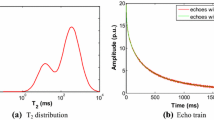Abstract
Prior to the advent of nuclear magnetic resonance (NMR) data inversion, a common approach for handling the large amount of raw echo data collected by NMR logging was data compression for improving the inversion speed. A fast compression method with a high compression ratio is required for processing NMR logging data. In this paper, we proposed a hybrid method to compress NMR data based on the window averaging (WA) and principal component analysis (PCA) methods. The proposed method was compared with the WA method and the PCA method in terms of the compression times of simulated one-, two-, and three-dimensional NMR data, the inversion times of compressed echo data, and the accuracy of NMR maps created with and without compression. We processed NMR log data and compared the inversion results with different compression methods. The results indicated that the proposed method with a high compression speed and a high compression ratio can be used for NMR data compression, and its accuracy depended on the precompressed echo number, and it is obvious that the method have practical applications for NMR data processing, especially for multi-dimensional NMR.






















Similar content being viewed by others
References
G.R. Coates, L.Z. Xiao, M.G. Prammer, in NMR Logging Principles and Applications (Haliburton Energy Services Sea Gulf Press, Houston, 1999), pp. 1–28
K.J. Dunn, D.J. Bergman, G.A. LaTorraca, in Nuclear Magnetic Resonance: Petrophysical and Logging Applications (Pergamon, New York, 2002), pp. 1–10
M.D. Hürlimann, L. Venkataramanan, C. Flaum, J. Chem. Phys. 117, 10223–10232 (2002)
N. Heaton, H.N. Bachman, C.C. Minh, E. Decoster, J. Lavigne, J. White, R. Carmona, Petrophysics 49, 172–186 (2008)
J. Guo, R. Xie, Y. Zou, Y. Ding, J. Geophys. Eng. 13, 285–294 (2016)
J.F. Guo, R.H. Xie, Y.L. Zou, Chin. J. Geophys. 59, 2703–2712 (2016). (in Chinese)
J. Guo, R. Xie, J. Nat. Gas Sci. Eng. 37, 502–511 (2017)
M.G. Prammer, SPE Annual Technical Conference and Exhibition (Society of Petroleum Engineers, New Orleans, 1994), pp. 55–64. https://doi.org/10.2118/28368-ms
A. Sezginer, Determining bound and unbound fluid volumes using nuclear magnetic resonance pulse sequences: U.S. Patent 5,363,041[P] (1994)
R. Sigal, Petrophysics 43, 38–46 (2002)
N.J. Heaton, C.C. Minh, J. Kovats, U. Guru, SPE Annual Technical Conference and Exhibition (Society of Petroleum Engineers, Houston, 2004), pp. 1–11. https://doi.org/10.2118/90564-ms
L. Zhu, C. Zhang, Y. Wei, X. Zhou, Y. Huang, C. Zhang, Interpretation 5, T341–T350 (2017)
R. Freedman, Method and apparatus for compressing data produced from a well tool in a wellbore prior to transmitting the compressed data uphole to a surface apparatus: U.S. Patent 5,381,092[P] (1995)
K.J. Dunn, G.A. LaTorraca, J. Magn. Reson. 140, 153–161 (1999)
Y.Q. Song, L. Venkataramanan, M.D. Hürlimann, M. Flaum, P. Frulla, C. Straley, J. Magn. Reson. 154, 261–268 (2002)
L. Venkataramanan, Y.Q. Song, M.D. Hürlimann, IEEE Trans. Signal Process. 50, 1017–1026 (2002)
J. Mitchell, T.C. Chandrasekera, L.F. Gladden, Prog. Nucl. Magn. Reson. Spectrosc. 62, 34–50 (2012)
Y. Zou, R. Xie, Comput. Geosci. 19, 389–401 (2015)
R. Bai, A. Cloninger, W. Czaja, P.J. Basser, J. Magn. Reson. 255, 88–99 (2015)
Y. Ding, R. Xie, Y. Zou, J. Guo, Appl. Magn. Reson. 47, 297–307 (2016)
J.P. Butler, J.A. Reeds, S.V. Dawson, SIAM J. Numer. Anal. 18, 381–397 (1981)
É. Chouzenoux, S. Moussaoui, J. Idier, F. Mariette, IEEE Trans. Signal Process. 58, 6040–6051 (2010)
Y. Zou, R. Xie, Y. Ding, A. Arad, Geophysics 81, D1–D8 (2016)
J. Guo, R. Xie, Y. Zou, G. Jin, L. Gao, C. Xu, Geophysics (2018). https://doi.org/10.1190/geo2017-0394.1
M. Prange, Y.Q. Song, J. Magn. Reson. 196, 54–60 (2009)
R. Salazar-Tio, B. Sun, Petrophysics 51, 208–218 (2010)
G.H. Golub, M. Heath, G. Wahba, Technometrics 21, 215–223 (1977)
Y.L. Zou, R.H. Xie, A. Arad, Petrol. Sci. 38, 237–246 (2016)
Acknowledgements
This project was funded by the National Natural Science Foundation of China (Grant No. 41674126), and China National Key Scientific and Technological Project for Oil & Gas and Coalbed Methane Development (Grant No. 2016ZX05031-001). The authors would like to thank the editors and reviewers for their constructive comments and suggestions.
Author information
Authors and Affiliations
Corresponding author
Rights and permissions
About this article
Cite this article
Guo, J., Xie, R. & Liu, H. A Hybrid Method for NMR Data Compression Based on Window Averaging (WA) and Principal Component Analysis (PCA). Appl Magn Reson 50, 73–101 (2019). https://doi.org/10.1007/s00723-018-1037-7
Received:
Revised:
Published:
Issue Date:
DOI: https://doi.org/10.1007/s00723-018-1037-7




